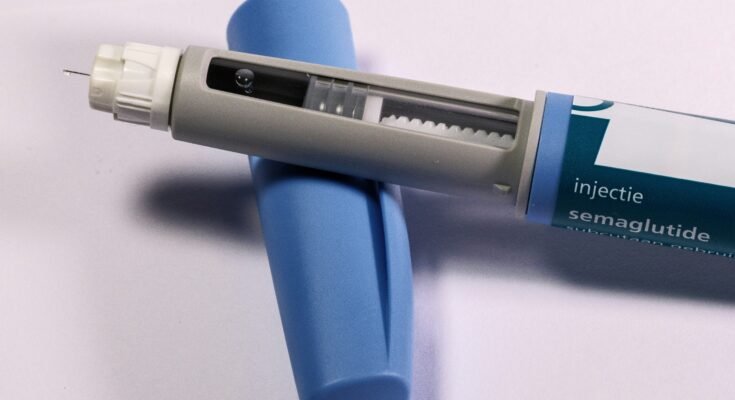Ozempic has rapidly gained popularity in diabetes management and weight loss therapy, becoming one of the most discussed medications in modern healthcare. Initially approved for the treatment of Type 2 Diabetes, Ozempic has also garnered attention for its ability to support significant weight reduction.
As more people begin using this medication or consider it as part of their treatment plan, questions like what is the half-life of Ozempic, how does it work, and how long does it stay in your system become essential to address. Understanding these aspects can help users take their medication correctly, manage side effects, and optimize results.
Semaglutide (brand name Ozempic) is an antidiabetogenic drug adapted to be used in combination with other treatments for type 2 diabetes in adults. The duration of action of Ozempic is long, and this is why it is sufficient to inject it once a week. The average person may keep Ozempic in the system up to 5 weeks following their last injection. It is normally used subcutaneously and its time-to-peak is a 24-hour onset and half-life life which is 5.7 to 6.7 days
This article will explain how Ozempic works in the body, what makes it unique as a once-weekly injection, and why its biological half-life matters for treatment planning.
What Is Ozempic?
To answer the question, what does Ozempic mean, it’s important to know that Ozempic is the brand name for the generic drug semaglutide. It is an injectable prescription medication that belongs to a class of drugs known as GLP-1 receptor agonists.
Ozempic is FDA-approved for use in adults with Type 2 Diabetes to help control blood sugar levels. Additionally, semaglutide under the brand name Wegovy has been approved for weight loss in individuals who are overweight or have obesity and at least one weight-related condition.
In simpler terms, Ozempic helps manage chronic metabolic conditions by supporting both blood glucose regulation and appetite suppression. Its dual utility has made it a revolutionary treatment option for many people living with diabetes or struggling with weight-related health risks.
Is Ozempic a GLP-1?
Yes, is Ozempic a GLP-1 is a common question, and the answer is straightforward: Ozempic is a GLP-1 receptor agonist, which means it mimics a naturally occurring hormone in your body called glucagon-like peptide-1 (GLP-1).
GLP-1 is a hormone released in response to food intake. It plays a key role in regulating:
- Insulin secretion
- Blood sugar levels
- Appetite
- Gastric emptying (how fast food leaves your stomach)
By mimicking GLP-1, Ozempic improves insulin release when glucose levels are high, helps reduce the amount of sugar the liver produces, and slows the rate at which food leaves your stomach. Together, these effects lead to better blood sugar control and reduced appetite, which may contribute to weight loss.
Ozempic: How Does It Work?
So, Ozempic—how does it work on a biological level?
The medication is designed to work through multiple physiological mechanisms:
- Insulin Secretion: It enhances the pancreas’s ability to release insulin in response to food, but only when blood glucose is elevated, reducing the risk of low blood sugar.
- Delayed Gastric Emptying: Ozempic slows the movement of food from the stomach to the intestines, which prolongs feelings of fullness and helps reduce calorie intake.
- Appetite Suppression: Acting on areas of the brain related to hunger, Ozempic reduces appetite and food cravings, which supports weight management.
This multifaceted mechanism helps individuals achieve more stable blood sugar levels throughout the day and can support weight reduction, particularly in those who also follow a reduced-calorie diet and exercise plan.
What Is the Half-Life of Ozempic?
Let’s dig into the pharmacokinetics: What is the half-life of Ozempic?
In simple terms, a half-life refers to the time it takes for the concentration of a drug in the body to decrease by 50%. It’s an essential concept in determining dosing schedules and how long the effects of the medication will last.
Ozempic has a remarkably long half-life of approximately 5 to 7 days. This extended half-life is one of the reasons why it only needs to be injected once a week.
Why Half-Life Matters
The long half-life means Ozempic remains active in your body for an extended period, ensuring stable blood levels and consistent therapeutic effects. It also improves patient compliance, as users do not have to remember daily injections or pills.
This unique characteristic makes Ozempic particularly attractive for people who struggle with adherence to daily medications.
How Long Is Ozempic in Your System?
Building on the discussion of half-life, many wonder: how long is Ozempic in your system?
Since the average half-life is around one week, it takes about 4–5 half-lives for the drug to be fully eliminated from the body. That means Ozempic can stay in your system for about 4 to 6 weeks after the last dose.
Factors That Influence Clearance
The time it takes to clear Ozempic can vary based on several factors:
- Dosage: Higher doses may take longer to leave the body.
- Kidney Function: Impaired kidney function can slow down drug clearance.
- Liver Health: The liver helps metabolize the drug, so liver conditions can affect how fast it is processed.
- Individual Metabolism: Each person metabolizes drugs differently, which can alter elimination time.
This prolonged presence in the system is also why doctors recommend a gradual titration schedule when initiating therapy, to allow the body to adjust and reduce side effects like nausea or gastrointestinal discomfort.
Semaglutide Names: Brand and Generic
Ozempic is just one of several semaglutide names available on the market. Understanding these names can help users recognize the medication when prescribed in different forms or for different uses.
Here are the main brand names for semaglutide:
- Ozempic: Injectable, used for Type 2 Diabetes
- Wegovy: Injectable, specifically approved for weight loss
- Rybelsus: Oral tablet, used for Type 2 Diabetes
While they all contain the same active ingredient—semaglutide—the formulations differ by delivery method and approved use. Ozempic and Wegovy are administered via subcutaneous injection once per week, whereas Rybelsus is taken as a daily pill.
Patients switching between forms should always consult a healthcare provider to ensure appropriate dosing and safe transitions between medications.
Conclusion
Ozempic represents a major advancement in diabetes and weight management treatment. As a GLP-1 receptor agonist, it mimics natural hormones in the body to help regulate blood sugar, control appetite, and promote weight loss.
Understanding how Ozempic works, what is the half-life of Ozempic, and how long it stays in your system provides crucial insight into its effectiveness and proper usage. With a half-life of 5–7 days, Ozempic remains active long enough to support convenient, once-weekly dosing while offering consistent therapeutic benefits.
Additionally, knowing the different semaglutide names like Ozempic, Wegovy, and Rybelsus helps users navigate options with confidence.
As with any medication, personalized advice from a healthcare professional is essential. Before starting or switching treatments, patients should discuss their health history, goals, and concerns with their doctor to ensure the best outcomes.
FAQ’s
How long does Ozempic stay in the body?
Ozempic (semaglutide) is an injectable medication that’s approved to treat Type 2 diabetes in adults. Ozempic lasts a long time in the body, which is why you only need to inject it once a week. For most people, Ozempic can stay in your system for around 5 weeks after your last dose.
What is the peak time for Ozempic?
It is typically administered subcutaneously, with a time-to-peak onset of 24 hours and a half-life of 5.7 to 6.7 days
Does Ozempic wear off at the end of the week?
The effects of a dose of Ozempic last for about one week—this is why it’s injected once-weekly. Some people may see a tapering of the effects towards the end of the one-week period, while others don’t.
What is the washout period for semaglutide?
We typically recommend a washout period of at least two to four weeks when switching between semaglutide and tirzepatide. This allows sufficient time for one medication to leave the system and reduces the risk of exacerbated side effects.

Emily Harper is a board-certified nurse practitioner and certified obesity medicine specialist with a strong clinical background in metabolic health and GLP-1 therapies. With years of frontline experience managing patients on Ozempic, she brings both scientific knowledge and real-world insight to her writing.




